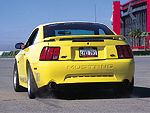
It's nice to make some progress on a project car. That seems like a pretty obvious statement, but when you've had a perfectly good automobile torn apart for a few months, it's great to finally get it back on the road. That's an even bigger deal when you now have state-of-the-art suspension underneath.
In this story, we'll chase the brakes on our in-house '02 Mustang GT, a problem we discovered after the first test for the December issue. Then, we smoked the rear brakes, and put some serious color into the front system at Hotchkis Track Day. Now, we're doing the ridiculously simple install of a Brembo Gran Turismo High Performance Brake system (for '94 to '03 vehicles), known in Mustang circles as the "Cobra R kit" (since it was used by Ford on that specific vehicle).
When you think Brembo, you probably think of Formula One or exotic street cars. Know that the Italian brake system giant is going after the American market in a big way, as witnessed by well engineered and nicely packaged kits like this one. As we mentioned a few issues back, Brembo has options to take this brake package even further, including more expensive kits that feature drilled and or slotted rotors, two-piece rotor systems, and even larger rotors that require very specific wheel fitments. What we've done here (PN 184.6001A) is most common and works on the street, and under serious track day and autocross conditions.
When we say it's a simple install, we aren't kidding. You simply unbolt the old 11.5-inch, PBR-based front brake system, including the bracket upon which it's mounted, and strap on the Brembo one-piece 13-inch rotor, aluminum four-piston caliper, and Goodridge stainless steel brakes line on each front corner. That's it! Bleed the system, bed the pads, and enjoy! Since we already have Discount Tire Direct's 17-inch Cobra R replica wheels, we had no problems with caliper clearance.
The pads are a major issue, however. This system, available for just over $1,000 from Maximum Motorsports (they're a Brembo dealer), usually ships with the same Pagid 421 brake pads that you'd find on a Ferrari F40 and F50, or a Porsche twin-turbo 996. This pad is a ton of fun, with great initial bite upon pedal travel and stability at temperature, but it needs serious heat to work correctly, and will wear down quickly. Plus, Pagid has no application for the Mustang's rear system (which has major heat issues on track days). To test properly and under realistic conditions you need similar pads front and rear, so we turned to Hawk Performance and its HPS pads, built for low dust and low noise and similar pad wear to the stock system. We call 'em the "street-strip" setup, because they work well enough for light track duty, but aren't as temperature sensitive so they won't burn up your rotors while running relatively cold on the street. The Hawk HPS swap is probably the first change you'd make on a new Mustang, especially if you're not in the market for an entire brake system. We could do an entire story just on how to select brake pads, but know that they're a lot like tires, in that they're designed to work at specific temps and wear is a direct result (as is dust). Look for more brake testing info in upcoming issues, especially when we go back to track testing--there's a bunch to cover.
Next month, we'll tackle the interior mods, with lots of gauges from Auto Meter, seats and belts from Corbeau, and we'll have some more track testing results on the suspension. For now, let's see how those big brakes work.
How Does the Suspension Work?
I'm going to make a big statement here, or as Kenny Bernstein would say in his Texas accent at the local Karaoke (sounding a bit like Elvis), "Dim the house lights, Tim. I've got somethin' to say..." The Maximum Motorsport suspension system that we bolted up over the last two issues is the single most significant improvement to a car that I've ever felt in six years on this magazine and another ten years of working with this type of equipment. It's that good.
Getting the Maximum "Grip in a Box" system on board wasn't easy, but it was worth it, providing incredible adjustment, road feel, and overall mechanical grip. One surprise we found was significant noise, part of which we expected since we were eliminated all of the rubber on the car for solid rod ends and urethane bushings. But, we were shocked at how much more noise, vibration, and harshness was transferred from the tires through the new chrome-moly suspension components. The old stamped steel stuff was engineered to dissipate noise, while this stuff was made to help you go fast. You hear the rear end's lash, the clutch, and every other moving part. It's a bit disconcerting, but if you want to feel like a racer, this is what it's like.
In upcoming months, we'll have more road course testing with lap times to compare how we ran in stock trim, but in the meantime, know that driving this car with it's changes provides a supercar feel. Its longer wheelbase, wider track, and weight savings from Maximum's new K-member, not to mention the weight reduction from the coil-over swap, the adjustable rear sway bar, subframe connectors, etc. All are major moves toward "race me home" superiority.